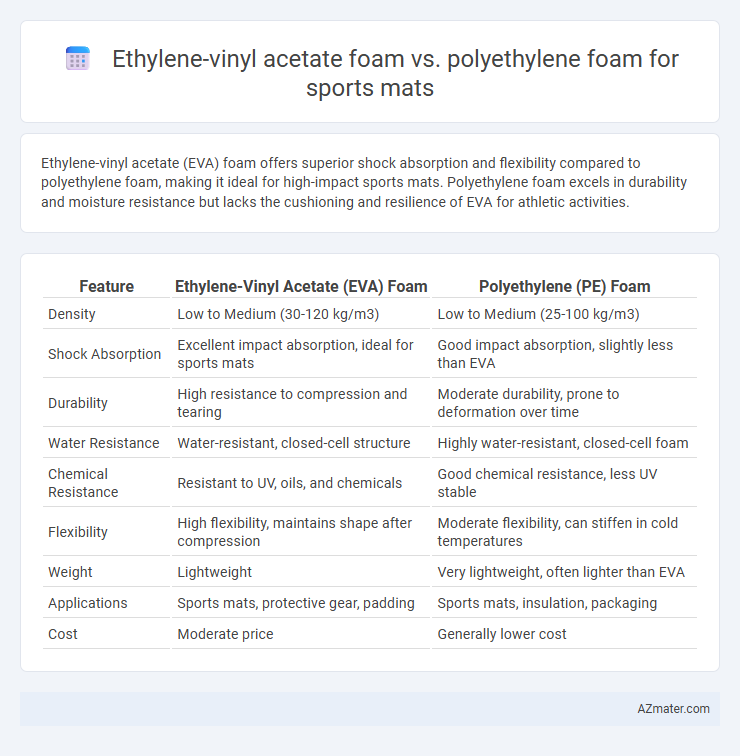Ethylene-vinyl acetate (EVA) foam offers superior shock absorption and flexibility compared to polyethylene foam, making it ideal for high-impact sports mats. Polyethylene foam excels in durability and moisture resistance but lacks the cushioning and resilience of EVA for athletic activities.
Table of Comparison
| Feature | Ethylene-Vinyl Acetate (EVA) Foam | Polyethylene (PE) Foam |
|---|---|---|
| Density | Low to Medium (30-120 kg/m3) | Low to Medium (25-100 kg/m3) |
| Shock Absorption | Excellent impact absorption, ideal for sports mats | Good impact absorption, slightly less than EVA |
| Durability | High resistance to compression and tearing | Moderate durability, prone to deformation over time |
| Water Resistance | Water-resistant, closed-cell structure | Highly water-resistant, closed-cell foam |
| Chemical Resistance | Resistant to UV, oils, and chemicals | Good chemical resistance, less UV stable |
| Flexibility | High flexibility, maintains shape after compression | Moderate flexibility, can stiffen in cold temperatures |
| Weight | Lightweight | Very lightweight, often lighter than EVA |
| Applications | Sports mats, protective gear, padding | Sports mats, insulation, packaging |
| Cost | Moderate price | Generally lower cost |
Introduction to Sports Mat Foams
Ethylene-vinyl acetate (EVA) foam offers superior shock absorption, flexibility, and durability, making it ideal for high-impact sports mats requiring enhanced comfort and resilience. Polyethylene (PE) foam provides excellent firmness and resistance to compression, suitable for lightweight, cost-effective mats with moderate cushioning needs. Both foams are closed-cell materials, but EVA's softer texture and better energy return contribute to improved athlete performance and injury prevention in sports applications.
What is Ethylene-Vinyl Acetate (EVA) Foam?
Ethylene-Vinyl Acetate (EVA) foam is a soft, flexible material known for its excellent shock absorption and cushioning properties, making it ideal for sports mats. Its closed-cell structure provides resistance to water, chemicals, and UV radiation, enhancing durability during intense physical activities. Compared to polyethylene foam, EVA foam offers superior elasticity and comfort, which helps reduce joint strain and impact injuries in athletic environments.
What is Polyethylene (PE) Foam?
Polyethylene (PE) foam is a closed-cell foam known for its excellent durability, shock absorption, and resistance to moisture, making it an ideal material for sports mats that require impact protection and comfort. Compared to ethylene-vinyl acetate (EVA) foam, PE foam offers higher density and superior resilience, which enhances stability during intense physical activities. Its lightweight and buoyant properties also contribute to effective cushioning and long-term performance in various athletic environments.
Key Physical Properties: EVA vs PE Foam
Ethylene-vinyl acetate (EVA) foam offers superior elasticity and shock absorption compared to polyethylene (PE) foam, making it ideal for sports mats requiring high cushioning and comfort. EVA foam exhibits excellent resilience and flexural strength, maintaining performance under repeated impact, while PE foam provides better rigidity and higher density for enhanced durability and firmness. Moisture resistance in PE foam surpasses EVA, but EVA's closed-cell structure ensures adequate water resistance combined with a softer texture, optimizing athlete safety and support during physical activities.
Cushioning and Shock Absorption Performance
Ethylene-vinyl acetate (EVA) foam offers superior cushioning and shock absorption for sports mats due to its high elasticity and resilience, effectively reducing impact forces during physical activities. Polyethylene (PE) foam provides firmer support but absorbs shocks less efficiently, making it more suitable for applications requiring stiffness and durability rather than maximum comfort. EVA's closed-cell structure enhances energy return and long-term performance, while PE foam's open-cell design prioritizes lightweight and moisture resistance.
Durability and Longevity Comparison
Ethylene-vinyl acetate (EVA) foam offers superior durability and elasticity compared to polyethylene (PE) foam, making it ideal for sports mats subjected to frequent impact and stress. EVA foam resists cracking and compression set better over time, maintaining cushioning and shock absorption under continuous use. Polyethylene foam, while lightweight and cost-effective, tends to degrade faster with repeated compression and exposure to moisture, resulting in shorter longevity for sports mat applications.
Comfort and User Experience
Ethylene-vinyl acetate (EVA) foam provides superior cushioning and shock absorption, enhancing comfort during prolonged use on sports mats compared to polyethylene foam, which tends to be denser and less flexible. EVA foam's closed-cell structure offers better resilience and energy return, improving user experience by reducing fatigue and joint stress. Polyethylene foam, while durable and firm, often sacrifices comfort and can lead to quicker discomfort during high-impact activities.
Safety and Toxicity Considerations
Ethylene-vinyl acetate (EVA) foam offers superior safety characteristics in sports mats due to its low toxicity and excellent shock absorption properties, reducing injury risks during high-impact activities. Polyethylene (PE) foam, while lightweight and durable, may release volatile organic compounds (VOCs) and lacks the same level of cushioning, potentially increasing safety concerns in prolonged or heavy use. Choosing EVA foam ensures a safer, non-toxic environment ideal for sports applications, meeting stringent safety standards.
Cost and Commercial Availability
Ethylene-vinyl acetate (EVA) foam offers moderate cost and widespread commercial availability, making it a popular choice for sports mats due to its durability and shock absorption. Polyethylene (PE) foam tends to be more affordable but may have limited commercial availability in larger thicknesses or densities required for high-impact sports applications. Both materials are commonly found in the sporting goods market, with EVA providing a premium option and PE serving as a budget-friendly alternative.
Choosing the Best Foam for Sports Mats
Ethylene-vinyl acetate (EVA) foam offers superior shock absorption, flexibility, and durability, making it ideal for high-impact sports mats requiring long-lasting performance and comfort. Polyethylene (PE) foam is denser and more rigid, providing excellent support and resistance to moisture, but may lack the cushioning needed for intense physical activities. Selecting the best foam depends on balancing EVA's cushioning properties with PE's structural support to match the specific demands of the sport and user safety.

Infographic: Ethylene-vinyl acetate foam vs Polyethylene foam for Sports mat
 azmater.com
azmater.com